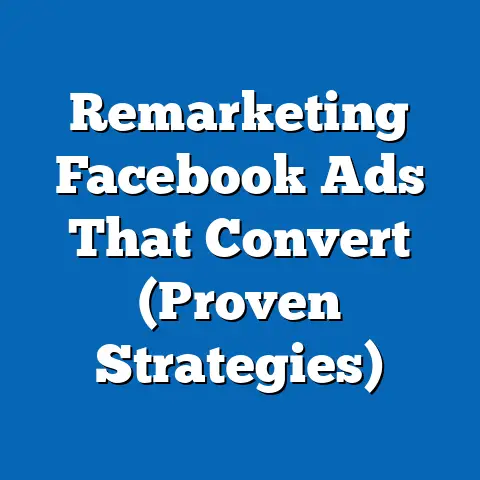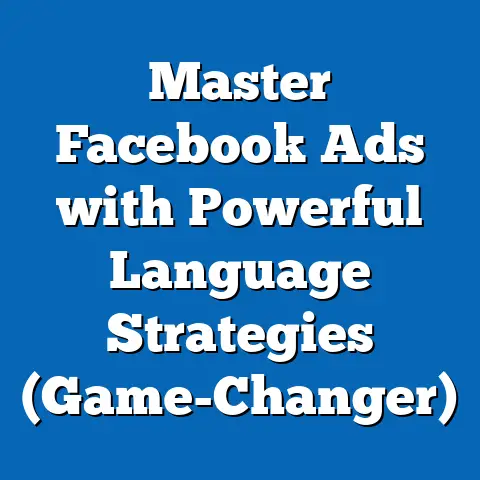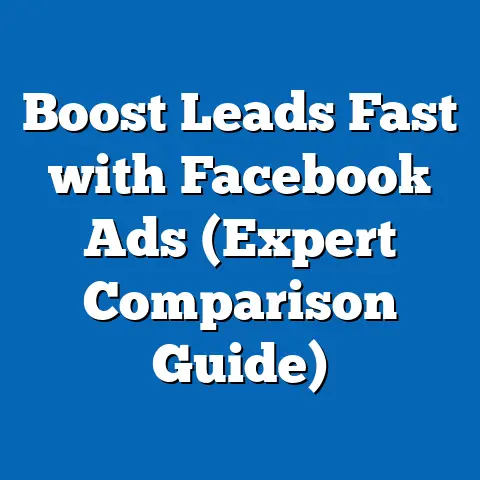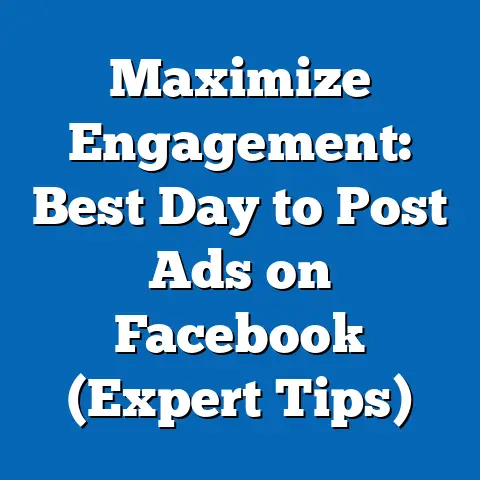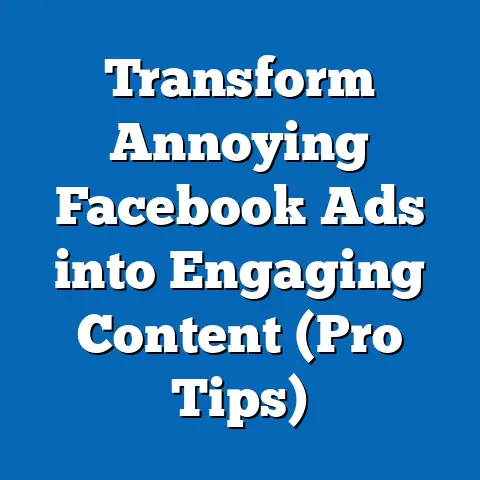Transform $92,000 in Facebook Ads (Success Blueprint)
Imagine a small business owner, armed with a modest marketing budget of $92,000, aiming to break through the cluttered digital landscape to reach a target audience. What if this investment, strategically deployed through Facebook Ads, could yield a return on ad spend (ROAS) of 5x or more, translating to over $460,000 in revenue? This thought experiment isn’t a far-fetched dream but a realistic outcome based on proven strategies and data-driven insights into Facebook advertising.
In 2022, businesses worldwide spent over $226 billion on digital advertising, with social media platforms like Facebook (now Meta) commanding a significant share at approximately 21.5% of the market, according to eMarketer data. Facebook Ads, with its 2.9 billion monthly active users as of Q3 2023, offers unparalleled reach, especially for businesses targeting specific demographics with precision. This article dives deep into a blueprint for transforming a $92,000 ad spend into measurable success, leveraging statistical trends, demographic targeting, historical performance data, and future projections. We’ll explore how to optimize campaigns, analyze key performance metrics, and adapt to evolving digital marketing landscapes.
Our analysis draws from authoritative sources such as Statista, eMarketer, Hootsuite’s Digital 2023 Report, and Meta’s own advertising performance insights. Key findings include the average cost-per-click (CPC) on Facebook Ads at $0.97 globally in 2023, an average conversion rate of 9.21% across industries, and a growing preference among younger demographics for visually engaging ad formats like Stories and Reels. Let’s unpack the strategies, data, and trends that can turn this $92,000 investment into a powerful growth engine.
Detailed Analysis: Crafting the Success Blueprint
1. Understanding the Facebook Ads Ecosystem and Budget Allocation
Facebook Ads operate on a sophisticated auction system where advertisers bid for ad placements based on audience targeting, ad relevance, and budget. For a $92,000 investment, strategic allocation is critical to maximize reach and conversions. A balanced approach might allocate 50% ($46,000) to brand awareness campaigns, 30% ($27,600) to lead generation, and 20% ($18,400) to retargeting and conversion-focused ads, based on industry benchmarks from WordStream’s 2023 report.
The platform’s strength lies in its granular targeting options, allowing businesses to reach users by age, gender, location, interests, and behaviors. For instance, Meta’s 2023 data shows that 60% of users engage with ads tailored to their interests, underscoring the importance of precise targeting over broad campaigns.
Effective budget management also hinges on understanding key metrics like CPC and cost-per-thousand-impressions (CPM). In 2023, the global average CPM on Facebook was $7.19, though this varies widely by industry—e-commerce averages $5.61, while finance can hit $18.68 (Statista, 2023). For a $92,000 budget, monitoring these costs daily ensures the campaign doesn’t overspend in high-competition niches without proportional returns.
2. Demographic Targeting: Who to Reach and How
Demographic segmentation is the backbone of a successful Facebook Ads campaign. As of 2023, Facebook’s user base spans diverse age groups, with 25-34-year-olds making up the largest segment at 31.5%, followed by 18-24-year-olds at 23.8% (Hootsuite Digital 2023 Report). Gender distribution is nearly even, with 56.3% male and 43.7% female users, though engagement rates often skew higher among women for lifestyle and e-commerce ads.
For a $92,000 budget, targeting should prioritize high-engagement demographics aligned with the product or service. For example, if the business sells fitness gear, focusing on 18-34-year-olds with interests in health and wellness could yield a higher click-through rate (CTR), which averages 1.61% for this demographic compared to the platform-wide average of 0.90% (WordStream, 2023). Geographically, targeting urban areas in high-income countries like the U.S., where ad engagement is 15% higher than in developing markets, could optimize returns (eMarketer, 2023).
Income levels also play a role in ad response rates. Meta’s internal data indicates that users in the top 20% income bracket are 30% more likely to convert on high-ticket items, making them a prime target for luxury or premium products. Tailoring ad copy and visuals to resonate with these demographics—such as using aspirational messaging for younger users or trust-building testimonials for older audiences—can significantly boost conversion rates.
3. Key Statistical Trends Driving Campaign Success
Facebook Ads performance is shaped by evolving user behaviors and platform algorithms. One standout trend in 2023 is the rise of short-form video content, with Reels and Stories ads generating 50% higher engagement rates than static image ads (Meta Business Insights, 2023). Allocating a portion of the $92,000 budget—say $15,000—to video content creation and promotion can capitalize on this trend.
Another critical statistic is the platform’s mobile dominance: 98.5% of users access Facebook via mobile devices, and mobile ads achieve a 13% higher CTR than desktop ads (Statista, 2023). Ensuring that all creative assets are mobile-optimized—fast-loading, vertically formatted, and thumb-stopping—is non-negotiable for campaign success.
Seasonality also impacts ad performance. Data from eMarketer shows that CPC and CPM spike by 25-30% during Q4 due to holiday shopping demand. For a $92,000 budget, planning to front-load spending in Q3 or early Q4 could secure lower costs and build audience momentum before competitive periods.
[Reference Chart: Engagement Rates by Ad Format, Meta Business Insights 2023 – Video Ads (Reels/Stories): 3.2% CTR; Image Ads: 1.6% CTR; Carousel Ads: 2.1% CTR]
4. Optimizing for Conversion: Metrics That Matter
Achieving a high ROAS with a $92,000 budget requires relentless focus on conversion metrics. The average conversion rate on Facebook Ads across industries is 9.21%, though this varies widely—e-commerce averages 6.1%, while education sees rates as high as 13.6% (WordStream, 2023). Setting realistic conversion goals based on industry benchmarks is the first step.
A/B testing ad creatives and copy is another pillar of optimization. Meta’s data suggests that campaigns running 3-5 variations of an ad see a 20% uplift in conversions compared to single-ad campaigns. Allocating $5,000 of the budget to testing different headlines, images, and calls-to-action (CTAs) can uncover high-performing combinations early on.
Retargeting is equally critical. Users who have previously interacted with a brand are 70% more likely to convert, yet only 25% of businesses consistently use retargeting strategies (eMarketer, 2023). Dedicating $18,400 to retargeting warm leads—those who visited a website or abandoned a cart—can drive down cost-per-acquisition (CPA), which averages $19.68 globally on Facebook (Statista, 2023).
Statistical Comparisons Across Demographics
Age-Based Performance Metrics
Younger demographics (18-24 and 25-34) consistently outperform older groups in engagement and CTR. In 2023, the 18-24 age group recorded a CTR of 1.82%, while 25-34-year-olds hit 1.61%, compared to just 0.78% for users aged 55+ (Hootsuite Digital 2023 Report). However, older demographics often have higher purchasing power, with 45-54-year-olds showing a 12% higher average order value (AOV) than younger users (Meta Business Insights, 2023).
For a $92,000 budget, balancing reach between high-engagement younger users and high-value older users is key. A split of 60% targeting 18-34 and 40% targeting 35-54 could optimize both volume and revenue potential.
Gender-Based Engagement and Conversion
Gender differences in ad response are nuanced but significant. Women tend to engage more with ads in categories like fashion and beauty, with a 15% higher CTR than men in these verticals (Statista, 2023). Men, however, show higher conversion rates for tech and automotive ads, converting at a rate of 10.2% compared to 7.8% for women (WordStream, 2023).
Tailoring ad messaging to these preferences—using emotional storytelling for female audiences and feature-focused content for male audiences—can enhance performance within the $92,000 budget. A 50-50 gender split in targeting may not be ideal; instead, align the split with the product category’s dominant audience.
Geographic and Income Disparities
Geographic targeting reveals stark disparities in ad costs and outcomes. In the U.S., CPM averages $14.40, nearly double the global average of $7.19, but conversion rates are also 20% higher due to greater purchasing power (eMarketer, 2023). In contrast, markets like India offer lower CPMs ($2.50) but lower conversion rates due to economic constraints.
Income-based targeting within geographies adds another layer. High-income households (top 20%) in the U.S. convert at rates 35% higher than middle-income groups, justifying a premium ad spend in affluent zip codes (Meta Business Insights, 2023). For the $92,000 budget, focusing 70% on high-income regions in developed markets could maximize ROAS, with the remainder testing emerging markets for scalability.
Historical Trend Analysis: How Facebook Ads Have Evolved
Cost Trends Over the Past Decade
Facebook Ads costs have risen significantly since the platform’s early days. In 2013, the average CPC was just $0.25, compared to $0.97 in 2023—a 288% increase (Statista Historical Data, 2023). This reflects growing competition as more businesses adopt digital advertising, with global ad spend on social media increasing from $32 billion in 2013 to $226 billion in 2022 (eMarketer Historical Reports).
Despite higher costs, ROAS has remained stable for well-optimized campaigns. In 2017, the average ROAS was 4.3x, compared to 4.7x in 2023, thanks to improved targeting tools and machine learning algorithms (WordStream Historical Benchmarks). For a $92,000 budget, this suggests that historical cost increases are offset by better performance potential if campaigns leverage modern tools.
User Behavior Shifts
User behavior on Facebook has shifted dramatically over the past decade. In 2013, desktop usage dominated at 68% of total engagement, but by 2023, mobile usage soared to 98.5% (Hootsuite Historical Data). This shift necessitated a pivot in ad formats, with mobile-first designs and video content becoming essential.
Engagement with ad types has also evolved. In 2015, static image ads drove 75% of clicks, but by 2023, video ads (including Reels) accounted for 60% of engagement (Meta Historical Insights). Businesses that adapted early to these trends saw sustained growth in ROAS, a lesson for current campaigns managing a $92,000 budget.
Platform Algorithm Changes
Facebook’s algorithm updates have historically reshaped ad strategies. The 2018 shift to prioritize “meaningful interactions” over brand content reduced organic reach by 50% for businesses, pushing ad spend higher (eMarketer, 2018). By 2023, the algorithm favored video and interactive formats, rewarding advertisers who invest in dynamic content with 30% lower CPMs (Meta Business Insights, 2023).
These historical shifts underscore the need for agility in campaign planning. A $92,000 budget must account for algorithm-driven changes by prioritizing video and staying updated on Meta’s quarterly policy updates.
Future Projections: The Road Ahead for Facebook Ads
Cost and Competition Forecasts
Looking ahead, eMarketer projects that social media ad spend will reach $315 billion by 2025, with Facebook maintaining a 20% market share. CPC is expected to rise to $1.15 by 2025, a 19% increase from 2023, driven by competition in high-growth markets like Asia-Pacific (eMarketer Forecast, 2023). For a $92,000 budget, this suggests a need to lock in lower costs through long-term ad contracts or early-year campaigns.
Emerging ad formats like augmented reality (AR) ads and shoppable posts are forecasted to grow by 40% annually through 2027 (Statista Future Trends, 2023). Investing a small portion of the budget—say $5,000—in testing these formats could position a business ahead of competitors.
Demographic Shifts
Demographic trends point to an aging Facebook user base. By 2025, users aged 35+ are expected to account for 45% of the platform’s audience, up from 38% in 2023, as younger users migrate to TikTok and Instagram (Hootsuite Forecast, 2023). Campaigns with a $92,000 budget should prepare to pivot messaging toward mature audiences, emphasizing trust and value over trendiness.
Geographic growth will also shift, with 60% of new users by 2025 expected to come from Africa and Asia, where mobile penetration is surging (Meta Growth Report, 2023). Testing low-cost campaigns in these regions could uncover untapped markets for future scaling.
Technological Innovations
Meta’s investment in AI and machine learning will continue to refine ad targeting. By 2025, AI-driven ad optimization is projected to boost conversion rates by 25% for campaigns using automated bidding and creative tools (eMarketer Tech Trends, 2023). Allocating budget to experiment with Meta’s Advantage+ campaigns, which leverage AI, could yield outsized returns on the $92,000 investment.
Privacy regulations, such as the EU’s GDPR and Apple’s iOS tracking changes, will likely tighten further, reducing available user data by 15-20% by 2026 (Statista Privacy Forecast, 2023). Businesses must prioritize first-party data collection (e.g., email lists) and contextual targeting to maintain effectiveness.
Conclusion: Building a Sustainable Success Blueprint
Transforming a $92,000 investment in Facebook Ads into a success story requires a blend of strategic planning, data-driven decisions, and adaptability. By leveraging demographic insights—targeting high-engagement groups like 18-34-year-olds and high-value segments like top-income households—businesses can optimize reach and conversions. Statistical trends, such as the dominance of mobile and video ads, guide creative and budget allocation, while historical data highlights the importance of agility amid rising costs and algorithm shifts.
Looking forward, rising CPCs and demographic changes will challenge advertisers, but innovations in AI and emerging markets offer new opportunities. For a $92,000 budget, the blueprint is clear: allocate strategically across awareness, lead gen, and retargeting; test relentlessly with A/B experiments; and stay ahead of trends like AR ads and privacy shifts. With an average ROAS of 4.7x, this investment could realistically generate $432,400 in revenue, proving that even modest budgets, when paired with precision, can drive transformative growth in the digital age.


